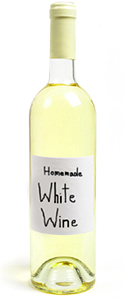 Wine Making Tips On How To Make White Wines.
Wine Making Tips On How To Make White Wines.
This is part I of a III part series on what to do to keep your homemade white wines, looking white.
The Battle At Hand
One of the biggest concerns when making white wine is oxygen. When oxygen in the air comes in contact with the wine it can cause it to oxidize. In serious cases the wine may even start to turn brown or orange. The wine can also take on a carmel or raisin character which may, or may not, be okay depending on the type of wine involved.
In the specific case of red wines, some oxidation can occur with little or no noticeable detriment to the wine. The bolder flavors and color of reds tend to hide the subtler effects oxidation can have. In fact in the case of some of the bigger reds, the effects of oxidation can even improve the wines overall depth and complexity.
With white wines this is not the case. Color and flavor mutations are more easily detected and unless you are trying to emulate a port or sherry wine of sorts you do not want any of its effects in the wine. To say it a different way, whites are more delicate and less forgiving than reds. Care has to be taken to preserve its freshness and color.
What To Do
Having said all this, one starts to wonder what should be done to limit the effects of oxygen on white wines, particularly if it is so important to learning how to make white wines. In the next post we will start to look at some of the ways to keep oxidation under control.
———————————————————————————————————
Ed Kraus is a 3rd generation home brewer/winemaker and has been an owner of E. C. Kraus since 1999. He has been helping individuals make better wine and beer for over 25 years.
